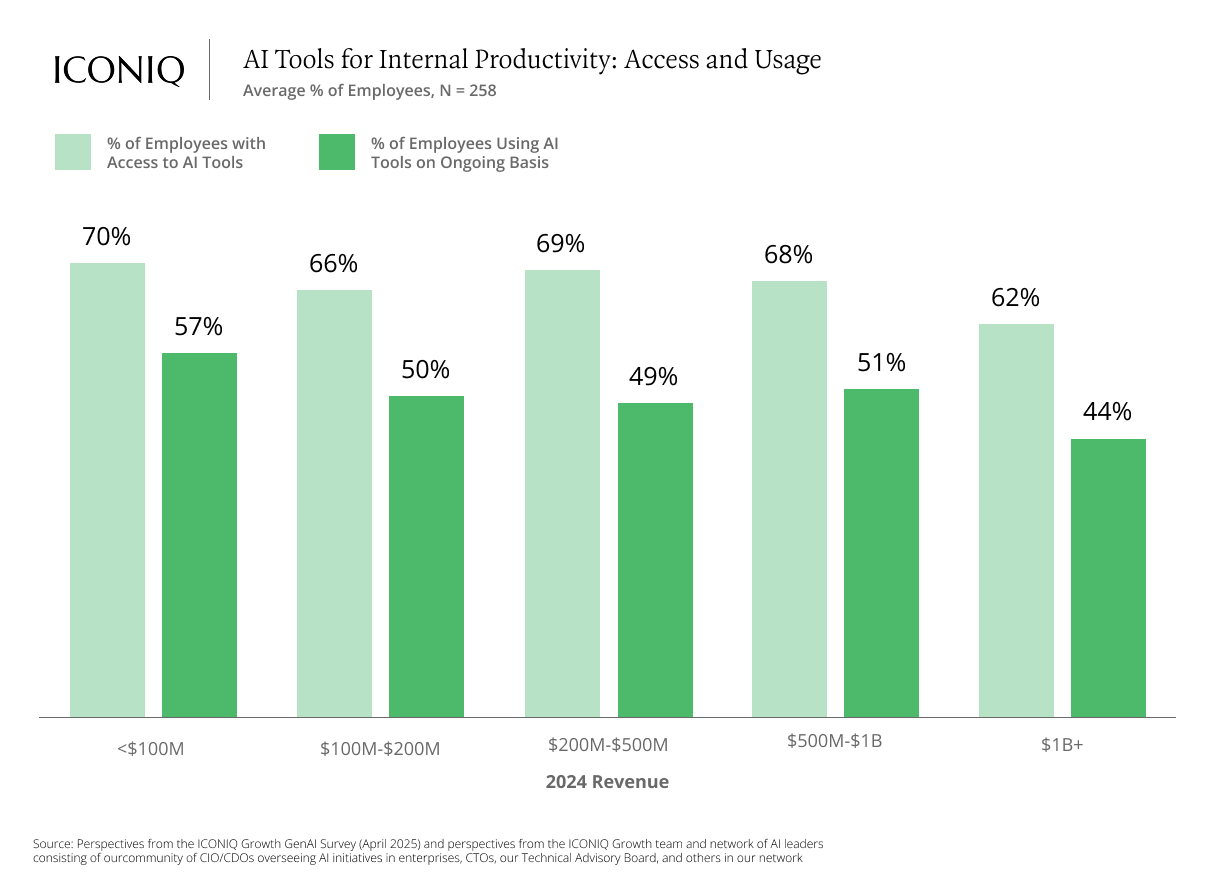- Weekly Olio
- Posts
- From Hype to How: 5 Lessons from the 2025 State of AI Report
From Hype to How: 5 Lessons from the 2025 State of AI Report
Discover 5 powerful lessons from ICONIQ’s 2025 State of AI report. Learn how top companies are building, scaling, and monetizing AI effectively—from strategy and pricing to talent, costs, and internal adoption.
Salutations, Olio aficionados! 👋
Welcome to the 174th edition of Weekly Olio. We’re thrilled to introduce a fresh new twist to your Sundays: Publisher Parmesan, our hand-picked, thoughtfully crafted edition designed to spark inspiration and insights for the week ahead.
It’s the perfect way to unwind, recharge, and prepare for the week with something truly worth savoring.
If you’re new here and you’re looking for more long-form, crispy writing, click the link to subscribe under this GIF 👇

A word from our Sponsors…
Launch Your Amazon Product to $100K+ in Revenue—Fast!
Want to quickly scale your new Amazon product launches into listings earning over $100K annually—in less than two months? Stack Influence makes it easy by automating thousands of micro-influencer collaborations each month. Say goodbye to complicated outreach, negotiating influencer fees, and managing complex campaigns. With Stack Influence, influencers are paid only in your products, creating authentic user-generated content (UGC) that drives real engagement and boosts your organic Amazon rankings.
Leading brands like Magic Spoon, Unilever, and MaryRuth Organics already rely on Stack Influence to achieve impressive sales growth, enhance brand visibility, and build genuine connections with customers. Fully automated management means effortless campaigns, giving you complete control without lifting a finger. Boost your listings, increase external traffic, and own full rights to impactful influencer-generated images and videos.
Experience rapid, stress-free growth and proven results with micro-influencer marketing.
From Hype to How: 5 Lessons from the 2025 State of AI Report
The AI hype cycle is over. What lies ahead is harder—and more rewarding. As companies shift from experimentation to execution, the defining question is no longer “Should we adopt AI?” but rather “How do we build, scale, and monetize it effectively?”
That’s the focus of ICONIQ’s 2025 State of AI report: The Builder’s Playbook. Drawing insights from a proprietary survey of 300 software executives and interviews with top AI leaders, the report offers a practical look at what it takes to deliver AI products that stick, scale, and pay off.
Here are the five most important takeaways for anyone actively building with AI.
1. AI Product Strategy Is Reaching a New Maturity Curve
The gap between AI-first and AI-enhanced companies is widening—and fast. According to the report, 47% of AI-native startups have achieved market fit at scale, compared to just 13% of traditional companies building AI-enabled features into legacy products.
What’s working? A sharp focus on:
Agentic workflows: 80% of AI-native builders are investing in agents that take multi-step actions on behalf of users.
Vertical solutions: Rather than generic tools, builders are solving deeply specific, high-value problems.
Multi-model architecture: On average, teams are deploying 2.8 models per product to balance performance, cost, and accuracy across tasks.
This marks a shift from novelty to utility. The winners aren’t just adding AI—they’re rethinking the user experience from the ground up.

2. AI Is Forcing a Rethink of Pricing Models
AI isn’t just changing products. It’s reshaping business models.
Pricing is shifting from flat subscriptions to hybrid models, where a base fee is combined with usage-based or even outcome-based pricing. In other words, customers pay for what they use—or what they get out of it.
Key stat: 37% of companies plan to change AI pricing structures in the next 12 months.
Currently, many offer AI features at no extra charge (a smart way to drive adoption early on), but as usage rises, so does the need for pricing that reflects real value—and usage cost. Companies that crack this equation early will be better positioned for sustainable growth.

CTV ads made easy: Black Friday edition
As with any digital ad campaign, the important thing is to reach streaming audiences who will convert. Roku’s self-service Ads Manager stands ready with powerful segmentation and targeting — plus creative upscaling tools that transform existing assets into CTV-ready video ads. Bonus: we’re gifting you $5K in ad credits when you spend your first $5K on Roku Ads Manager. Just sign up and use code GET5K. Terms apply.
3. Talent Strategy Is Emerging as a Core Competitive Edge
Building with AI isn’t just about technology—it’s about talent. And talent is becoming the ultimate bottleneck.
Most companies expect 20-30% of their engineering team to focus on AI in the next two years.
In high-growth companies, that number climbs to 37%.
But AI/ML engineers are the hardest roles to fill, with average time-to-hire exceeding 70 days.
More than half of surveyed companies say they’re falling behind in hiring, largely due to a shallow talent pool.
The top performers are forming cross-functional squads—ML engineers, data scientists, AI PMs—and investing early in upskilling and internal mobility. As AI matures, organizations that solve for talent early will pull ahead fast.

4. AI Budgets Are Surging—and Hitting the P&L
What used to be a side bet is now a core line item.
AI is now consuming 10–20% of R&D budgets across companies of all sizes. And that figure is climbing. While early-stage teams spend the most on talent, at scale, cloud, inference, and governance costs take center stage.
This evolution has real implications:
Teams must manage inference cost per user as aggressively as they once managed CAC.
FinOps and MLOps are no longer back-office functions—they're strategic levers.
As AI becomes integral to GTM and core products, its costs (and returns) are coming under executive scrutiny.
The companies that survive this shift will be those that combine technical innovation with cost discipline.

5. Internal AI Adoption Is Rising—but Unevenly
Most companies give 70% of employees access to internal AI tools. But only about half of them actually use those tools regularly.
What separates high-adoption companies? Breadth of use cases. Organizations with 50%+ internal usage tend to deploy AI across at least seven different workflows, including:
Coding assistants (77%)
Content generation (65%)
Searchable documentation (57%)
Where AI is embedded across the toolchain—not just bolted on—productivity gains of 15–30% are being realized.
The lesson? Adoption isn’t about access. It’s about utility, training, and change management—especially in larger, more established orgs.

The 2025 State of AI report doesn’t just chart where we are. It maps where we’re going.
If 2023–24 was the era of AI experimentation, 2025 is about execution. The takeaway is clear: AI isn’t a feature. It’s a shift. The companies that treat it as such—tactically and strategically—are the ones that will define this next chapter.
Interested in learning more about AI space? Check out our previous coverage here:
That’s all for this week. If you enjoyed this edition, we’d really appreciate if you shared it with a friend, family member or colleague.
We’ll be back in your inbox 2 PM IST next Sunday. Till then, have a productive week!
Disclaimer: The views, thoughts, and opinions expressed in the text belong solely to the author, and not necessarily to the author's employer, organization, committee or other group or individual.




Reply